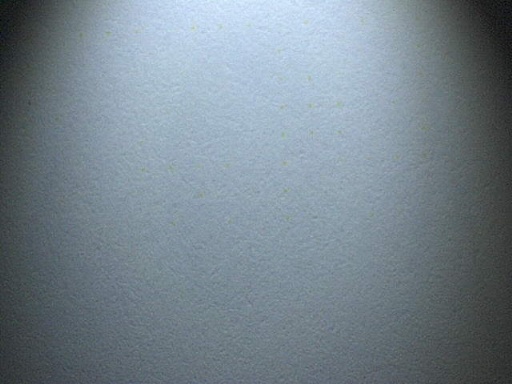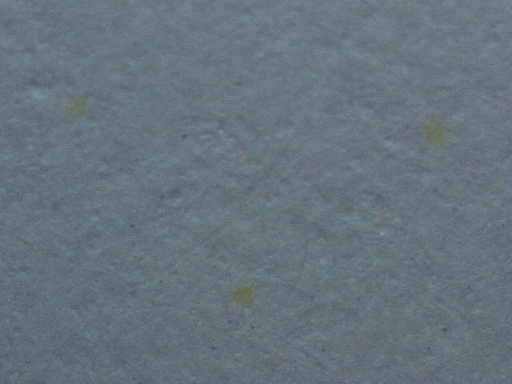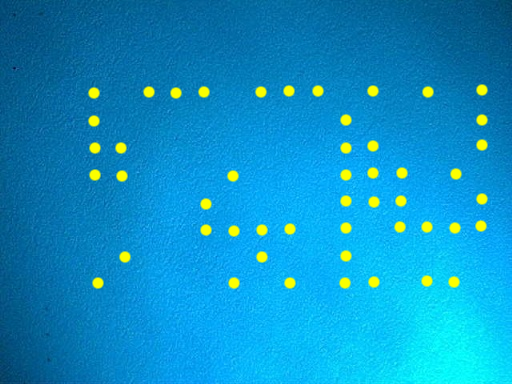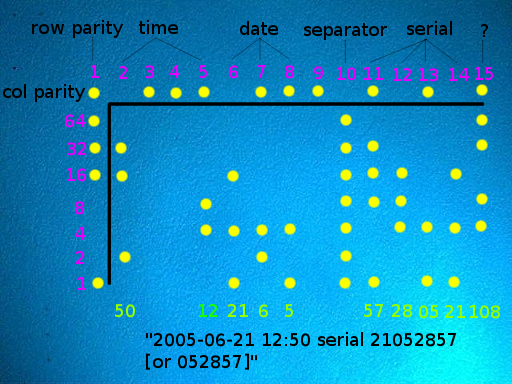DocuColor Tracking Dot Decoding Guide
This guide is part of the Machine Identification Code Technology project. It explains how to read the date, time, and printer serial number from forensic tracking codes in a Xerox DocuColor color laser printout. This information is the result of research by Robert Lee, Seth Schoen, Patrick Murphy, Joel Alwen, and Andrew "bunnie" Huang. We acknowledge the assistance of EFF supporters who have contributed sample printouts to give us material to study. We are still looking for help in this research; we are asking the public to submit test sheets or join the printers mailing list to participate in our reverse engineering efforts.
The DocuColor series prints a rectangular grid of 15 by 8 miniscule yellow dots on every color page. The same grid is printed repeatedly over the entire page, but the repetitions of the grid are offset slightly from one another so that each grid is separated from the others. The grid is printed parallel to the edges of the page, and the offset of the grid from the edges of the page seems to vary. These dots encode up to 14 7-bit bytes of tracking information, plus row and column parity for error correction. Typically, about four of these bytes were unused (depending on printer model), giving 10 bytes of useful data. Below, we explain how to extract serial number, date, and time from these dots. Following the explanation, we implement the decoding process in an interactive computer program.
Because of their limited contrast with the background, the forensic dots are not usually visible to the naked eye under white light. They can be made visible by magnification (using a magnifying glass or microscope), or by illuminating the page with blue instead of white light. Pure blue light causes the yellow dots to appear black. It can be helpful to use magnification together with illumination under blue light, although most individuals with good vision will be able to see the dots distinctly using either technique by itself.
This is an image of the dot grid produced by a Xerox DocuColor 12, magnified 10x and photographed by a Digital Blue QX5 computer microscope under white light. While yellow dots are visible, they are very hard to see. We will need to use a different technique in order to get a better view.
 This is an image of a portion of the dot grid under 60x magnification. Now the dots are easy to see, but their overall structure is hard to discern because the microscope field only includes a few dots at a time.
This is an image of a portion of the dot grid under 60x magnification. Now the dots are easy to see, but their overall structure is hard to discern because the microscope field only includes a few dots at a time.
 This is an image of one repetition of the dot grid from the same Xerox DocuColor 12 page, magnified 10x and photographed by the QX5 microscope under illumination from a Photon blue LED flashlight. Note that the increased contrast under blue light allows us to see the entire dot pattern clearly.
This is an image of one repetition of the dot grid from the same Xerox DocuColor 12 page, magnified 10x and photographed by the QX5 microscope under illumination from a Photon blue LED flashlight. Note that the increased contrast under blue light allows us to see the entire dot pattern clearly.
 The illumination is from the lower right; to the upper and lower left of the image, the corners of another repetition of the dot grid are visible.
Here, we use computer graphics software to overlay the black dots in the microscope image with larger yellow dots for greater visibility. (Because these computer-generated dots are significantly larger than the original dots, this image is no longer to scale and is now a schematic representation of the relative position of the dots.)
The illumination is from the lower right; to the upper and lower left of the image, the corners of another repetition of the dot grid are visible.
Here, we use computer graphics software to overlay the black dots in the microscope image with larger yellow dots for greater visibility. (Because these computer-generated dots are significantly larger than the original dots, this image is no longer to scale and is now a schematic representation of the relative position of the dots.)
 Finally, we add explanatory text to show the significance of the dots.
Finally, we add explanatory text to show the significance of the dots.
 The topmost row and leftmost column are a parity row and column for error correction. They help verify that the forensic information has been read accurately (and, if a single dot has been read incorrectly, to identify the location of the error). The rows and columns all have odd parity: that is, every column contains an odd number of dots, and every row (except the topmost row) contains an odd number of dots. If any row or column appears to contain an even number of dots, it has been read incorrectly.
Each column is read top-to-bottom as a single byte of seven bits (omitting the first parity bit); the bytes are then read right-to-left. The columns (which we have chosen to number from left to right) have the following meanings:
The topmost row and leftmost column are a parity row and column for error correction. They help verify that the forensic information has been read accurately (and, if a single dot has been read incorrectly, to identify the location of the error). The rows and columns all have odd parity: that is, every column contains an odd number of dots, and every row (except the topmost row) contains an odd number of dots. If any row or column appears to contain an even number of dots, it has been read incorrectly.
Each column is read top-to-bottom as a single byte of seven bits (omitting the first parity bit); the bytes are then read right-to-left. The columns (which we have chosen to number from left to right) have the following meanings:
- 15: unknown (often zero; constant for each individual printer; may convey some non-user-visible fact about the printer's model or configuration)
- 14, 13, 12, 11: printer serial number in binary-coded-decimal, two digits per byte (constant for each individual printer; see below)
- 10: separator (typically all ones; does not appear to code information)
- 9: unused
- 8: year that page was printed (without century; 2005 is coded as 5)
- 7: month that page was printed
- 6: day that page was printed
- 5: hour that page was printed (may be UTC time zone, or may be set inaccurately within printer)
- 4, 3: unused
- 2: minute that page was printed
- 1: row parity bit (set to guarantee an odd number of dots present per row)
The printer serial number is a decimal number of six or eight digits; these digits are coded two at a time in columns 14, 13, 12, and 11 (or possibly just 13, 12, and 11); for instance, the serial number 00654321 would be coded with column values 00, 65, 43, and 21.
We have prepared a computer program to automate this decoding process. Below, you can interactively enter a dot grid from a DocuColor page and have it interpreted by our program. If you don't have a microscope, a magnifying glass should be a practical substitute.
EFF does not log the information submitted to this web form or the results it returns. If you prefer, you can download the source code of this program, which we have licensed under the GNU General Public License.
https://w2.eff.org/Privacy/printers/docucolor/
Hilariouse! Donald Trump approved sanctions against Russia...what a fait divers for the Joseph Nobodies...I suppose that includes the majority of the US Congress ..lol!
Cylink Corporation has made encryption security products for networking, for over 16 years. Those products are built by foreign nationals and used by businesses, banks and governments around the world, including in the United States. Cylink has managed to export product without United States restriction, including to embargoed nations.
1. NASDAQ Ticker: CYLK
2. Pittway Corporation funded Cylink. The Harris family holds majority control in Pittway Corporation.
3. Cylink began as a partnership founded in 1984.
4. Cylink incorporated in 1989.
5. Cylink makes high grade encryption products and sold the products to organized crime.
6. Cylink was managed by Dr. Jimmy K. Omura, Louis Morris, Robert Fougner and Dr. Leo Guthart. Dr. Leo Guthart is the Vice-Chairman of the Board of Directors of Pittway Corporation.
7. Dr. Jimmy K. Omura has received several awards from the Director of the National Security Agency over the years.
8. Cylink enters into a number of contracts with the United States government to develop high grade encryption products.
9. Robert Fougner was Louis Morris's personal attorney, and manages Cylink's export licensing.
10. In the early 1990's, Dr. Jimmy K. Omura (Chief Technology Officer), Louis Morris (Chief Executive Officer) and Robert Fougner (Cylink attorney) created a joint venture with an engineering company based in Armenia named Hylink.
11. The senior Hylink executive is a ranking KGB officer named (General?) Gurgen Khchatrian.
12. The KGB trained field officer reporting to Khchatrian is named (Colonel?) Gaigic Evoyan. Evoyan travels to Cylink frequently. Evoyan travels with his own bodyguards. The FBI monitored Evoyan' s movements when he was traveling to Cylink.
13. The Russians travel into the United States under Armenian passports as Hylink engineers and wives.
14. The Hylink engineers enter the United States on business visas. Robert Fougner arranges to pay the engineers salary and all expenses in cash while the Hylink engineers are working at Cylink.
15. The Hylink engineers and their wives have unrestricted access to all Cylink facilities and encryption software source code and design information.
16. The Hylink engineers and Cylink develop and Cylink sells encryption products to various US Government departments including the United States Department of Defense and the Department of Justice.
17. Cylink sold their encryption products into United States banks and the United States Federal Reserve funds transfer system ("FedNet").
18. The Cylink engineering team and the Hylink engineers reported to the Cylink engineering Vice-president Leslie Nightingale. The engineers developed cryptography based networking product for the equivalent of the Federal Reserve funds transfer system in Europe, which is called S.W.I.F.T.
19. Cylink has exported high grade computers and encryption source code to Lebanon without being required to use United States export licenses arranged by Cylink.
20. Cylink has exported high grade encryption products to Iran, Iraq, Turkey and into several African nations.
21. Cylink has transferred high grade cryptography source code including its RSA source code to Hylink in Armenia. RSA encryption is the most secure cryptographic code available in the world at the time.
22. Some Hylink engineers brought into the United States to work in Cylink engineering are: Ashot Andreasyan, Nubarova Melik, Andre Melkoumian, Galina Melkoumian, Leonid Milenkiy, Mihran Mkrtchian, Elizabeth Mkrtchian, Karen Zelenko.
23. Cylink became a publicly traded company (CYLK) m 1996.
24. Pittway Corporation maintained sixty percent controlling stock in Cylink.
25 Founding CEO Louis Morris suffered a health problem and retired from Cylink.
26. Fernand Sarrat was recruited from IBM to replace Morris as CEO.
27. Fernand Sarrat and other select employees such as Dr. Jimmy K. Omura, John Kalb, and John Marchioni traveled to France, Belgium and Israel for a series of meetings.
28. Cylink purchased Algorithmic Research Limited, a small company in Israel selling encryption product outside of the United States.
29. The Director of the National Security Agency, federal prosecutors and several United States law enforcement agencies met in California to discuss Cylink. A two day meeting in 1997 took place in mid August.
30. Retired Secretary of Defense Perry joined the Cylink Board of Directors.
31. National Security Agency deputy director William Crowell joined Cylink in a marketing role.
32. High grade encryption products continued to be shipped outside of the United States by Cylink without export licenses.
33. Dr. Jimmy K. Omura left Cylink when Cylink sold its wireless products division to PCOM in Campbell, California.
34. A United States law enforcement agency seizes a multi-million dollar Cylink transshipment of high grade encryption products destined to the nation of Iran through the UAE. The criminal investigation against Cylink is put on hold.
35. Fernand Sarrat and the Cylink chief financial officer John Daws are implicated internally in a revenue accounting fraud with the vice president of sales, and terminated from Cylink employment
36. William Crowell becomes CEO of Cylink.
37. President Clinton appoints Cylink CEO William Crowell to a special committee on encryption. William Crowell releases publicity statements on new recommendations about United States encryption policy and certain export regulations are relaxed, waiving Cylink's earlier export violations.
38. Honeywell purchased Pittway Corporation.
what's the funny part?
31 March 2000
Khatchatrian and his direct report are genuine KGB from old school.
It is obvious your NSA arranged joint venture with Cylink and Hylink groups for years. Your NSA thought they could trust Americans at Cylink. NSA people thought they could manage the operation. NSA lost control to KGB to benefit themselves and Russian Mafia friends. No one and Cylink lawyers denied statements made by first anonymous sender.
Sending strong encryption source code between America and Armenia with no Americans in real control is done with bribes and secret agreement with state security. Baksheesh and state security make good partners even in America. Who was fox and who was hound? Someone ask your attorney general in Washington.










